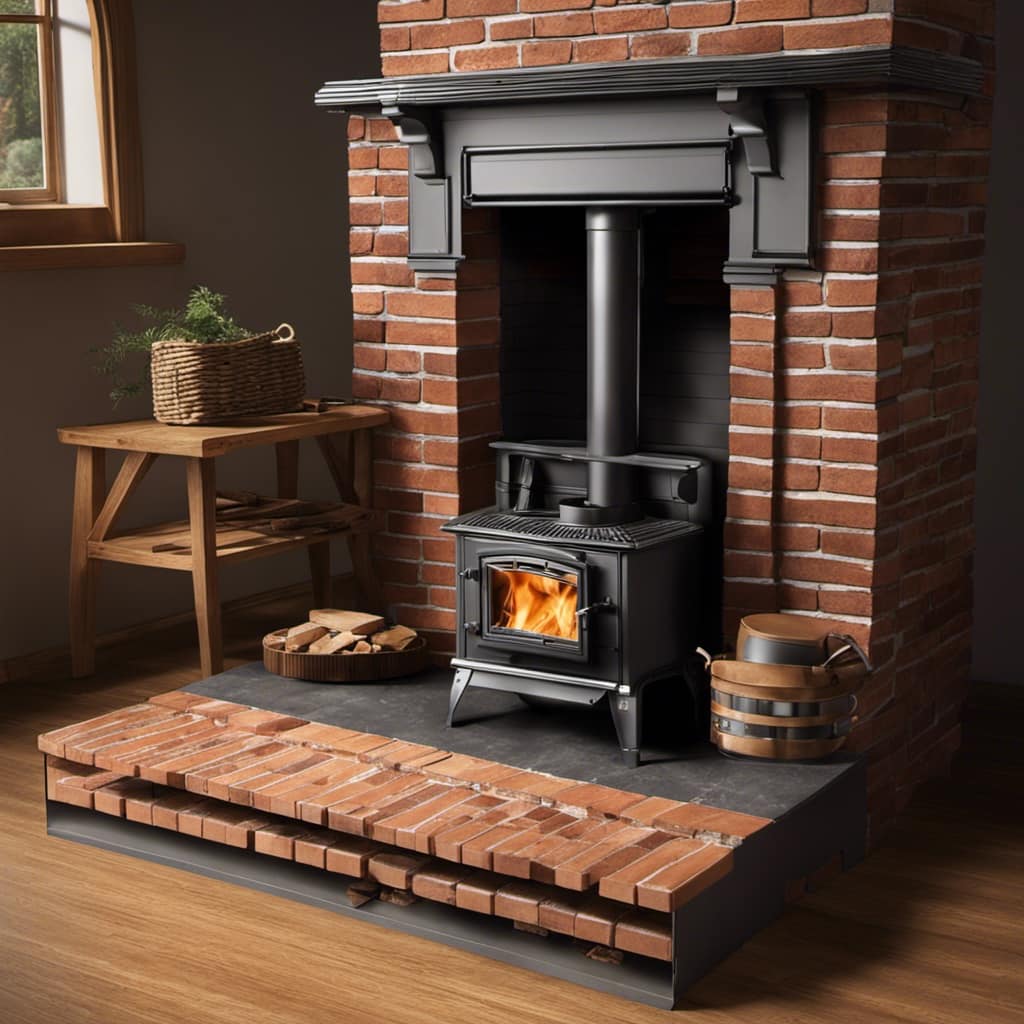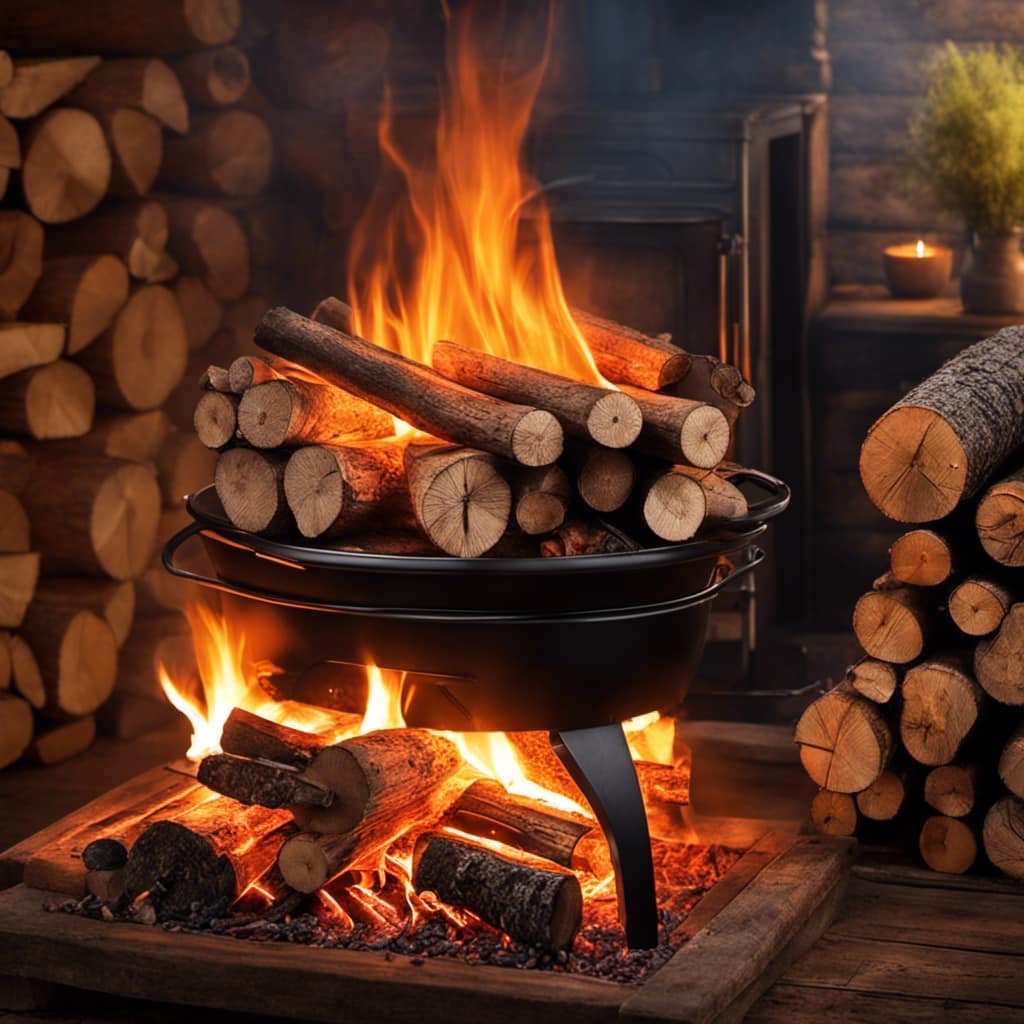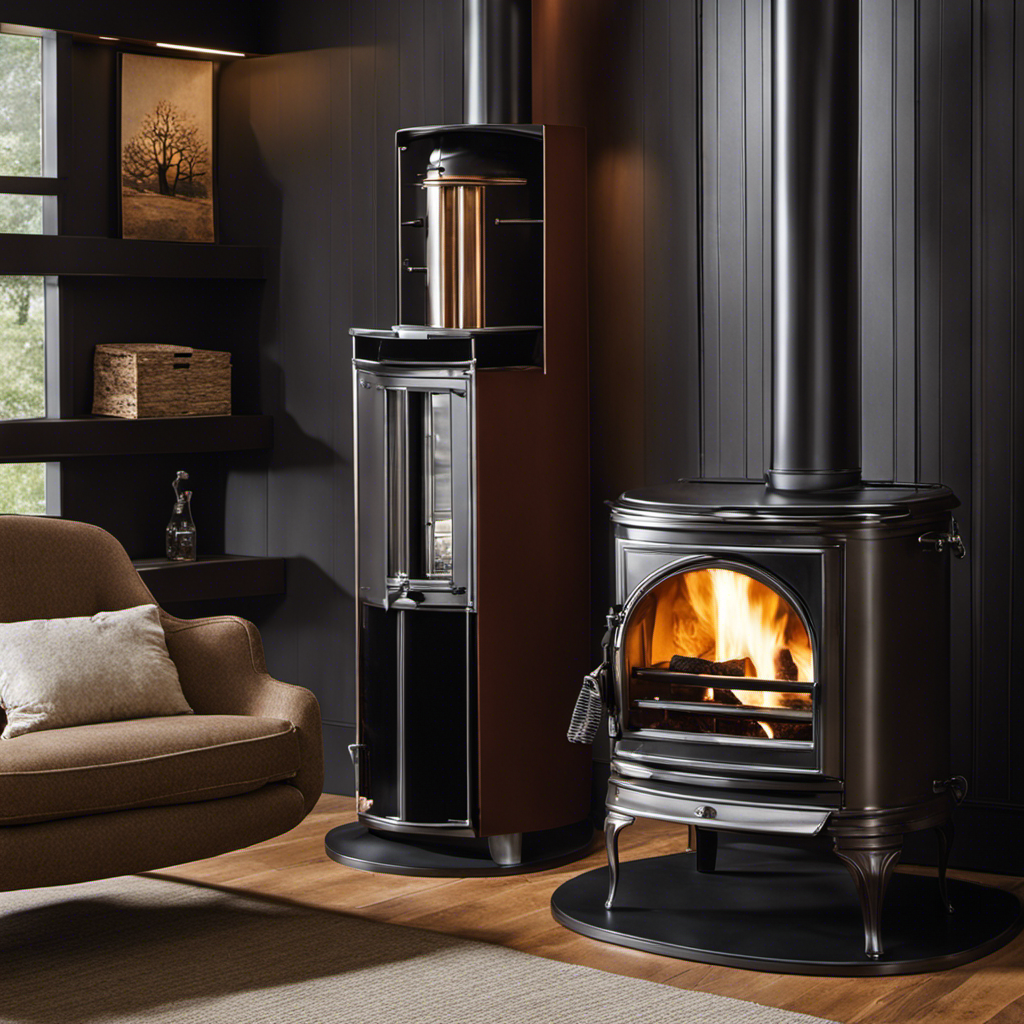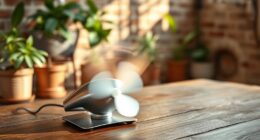The saying ‘knowledge is power’ is especially relevant when it comes to wood stoves, emphasizing the importance of knowing about the secondary burn process. In this article, my goal is to help you recognize the signs of a successful secondary burn and show you how to control airflow for the best possible performance.
Proper wood stove maintenance is crucial for achieving a secondary burn, and I’ll share troubleshooting tips to help you overcome common issues.
Get ready to unlock the secrets of secondary burn in your wood stove and maximize its performance.
Key Takeaways
- Secondary burn is essential for complete combustion, less smoke, and increased heat production in wood stoves.
- Monitoring temperature and airflow is crucial for achieving a successful secondary burn.
- Proper maintenance, including regular cleaning and using dry firewood, maximizes the benefits of secondary burn.
- Troubleshooting common issues like draft, air supply, and cold firebox can help optimize secondary burn efficiency.
Understanding the Secondary Burn Process
I’m really interested in understanding the secondary burn process and how it can improve the efficiency of my wood stove. The secondary burn mechanisms are crucial for maximizing the heat output and minimizing the emissions produced by the stove.

When wood burns, it goes through two stages: primary and secondary combustion. During primary combustion, the wood releases gases and creates a flame. In secondary combustion, these gases are reignited and burned at a higher temperature. This process leads to a more complete combustion of the wood, resulting in less smoke and increased heat production.
Optimizing the secondary burn temperature is essential for achieving this efficient combustion. It requires maintaining a temperature high enough to ignite the gases but not so high that it causes damage to the stove or chimney.
Understanding and controlling the secondary burn process can significantly enhance the performance of your wood stove.
Indicators of a Successful Secondary Burn
Successfully achieving a secondary burn in a wood stove can noticeably improve its efficiency and heat output, but it’s important to carefully monitor the temperature and airflow. A secondary burn occurs when the temperature inside the stove reaches a certain point, usually around 600-900 degrees Fahrenheit. This high temperature allows for the complete combustion of the wood, resulting in less smoke and more heat. To optimize the secondary burn duration, it’s crucial to maintain a steady airflow. Opening the air vents too much can lead to a rapid burn, while closing them too much can cause the fire to smolder. By finding the right balance and keeping an eye on the temperature, you can ensure a successful secondary burn and maximize the performance of your wood stove.

| Temperature Range (°F) | Secondary Burn Status |
|---|---|
| Below 600 | No secondary burn |
| 600-900 | Successful secondary burn |
| Above 900 | Overheating, monitor carefully |
Monitoring Airflow for Secondary Burn Efficiency
Monitoring the airflow is crucial for achieving and maintaining an efficient secondary burn in a wood stove. A secondary burn is when the gases and particles released during the initial combustion phase are re-burned, resulting in increased heat output and reduced emissions. To optimize combustion and ensure a successful secondary burn, it’s important to monitor the temperature and airflow within the stove.
Here are three key factors to consider:
Temperature: Monitoring the temperature inside the stove is essential for determining if the secondary burn is occurring at the desired level. A temperature range of 1000-1200 degrees Fahrenheit is generally recommended for efficient secondary combustion.
Air intake: Proper airflow is necessary for the combustion process. Ensure that the air intake vents are open to allow sufficient oxygen for the secondary burn. Adjusting the vents can help control the airflow and optimize combustion.

Fuel quality: The type and quality of wood used in the stove can greatly impact the secondary burn. Dry, seasoned hardwoods with low moisture content are ideal as they burn more efficiently and produce less smoke and creosote buildup.
Importance of Proper Wood Stove Maintenance for Secondary Burn
Maintaining my wood stove properly is crucial for achieving and sustaining a successful secondary burn. Regular cleaning is of utmost importance to ensure optimal performance. A buildup of creosote and other debris can hinder the airflow, diminishing the efficiency of the secondary burn. By regularly inspecting and cleaning the stove, I can prevent these issues and maintain a clean and efficient burn.
Another key factor is using dry firewood. Moisture content in firewood not only affects the overall burn time but also the ability to achieve a secondary burn. Dry firewood burns hotter and more efficiently, allowing for a better secondary burn.
By following these maintenance practices and using dry firewood, I can maximize the benefits of a secondary burn in my wood stove.

Now, let’s discuss troubleshooting common issues with secondary burn in wood stoves.
Troubleshooting Common Issues With Secondary Burn in Wood Stoves
I have encountered a few common issues with secondary burn in my wood stove, but by troubleshooting them, I’ve been able to improve the efficiency of my burn.
Here are three common issues and their solutions:
Drafty Stove: A drafty stove can prevent proper air circulation, leading to a weak secondary burn. To troubleshoot, check for gaps or cracks in the stove’s seals and gaskets. Replace any damaged parts and ensure a tight seal.

Insufficient Air Supply: If your wood stove lacks sufficient air supply, secondary burn won’t be optimized. Make sure the air vents are fully open and not blocked by debris. Consider installing an air intake system to enhance airflow.
Cold Firebox: A cold firebox can hinder secondary burn. Ensure your wood stove is properly insulated and use dry, seasoned wood to maintain higher temperatures. Additionally, avoid overloading the stove with too much wood, as it can restrict airflow.
Is having an open flue important for achieving a secondary burn in a wood stove?
Having the wood stove flue open indicator is crucial for achieving a secondary burn. The open flue allows sufficient airflow to facilitate the combustion process, resulting in a more efficient and cleaner burn. It also helps to prevent the build-up of creosote and ensures the wood stove operates safely and effectively.
Frequently Asked Questions
Can I Achieve a Secondary Burn in My Wood Stove Without Proper Maintenance?
Without proper maintenance, achieving a secondary burn in a wood stove may be challenging. However, it is important to understand the benefits of a secondary burn and be aware of signs indicating its occurrence.
How Often Should I Clean My Wood Stove to Maintain Secondary Burn Efficiency?
I clean my wood stove regularly to maintain secondary burn efficiency. It’s important to keep up with maintenance to ensure optimal performance. Remember, "An ounce of prevention is worth a pound of cure."

Can I Use Any Type of Wood to Achieve a Successful Secondary Burn?
Any type of wood can be used for a successful secondary burn in a wood stove, as long as it is properly seasoned and dry. However, it is important to ensure proper ventilation in the stove to achieve optimal efficiency.
Is It Normal for Smoke to Come Out of the Chimney During a Secondary Burn?
During a secondary burn, it is not normal for smoke to come out of the chimney. Excessive smoke can be caused by factors like inadequate air supply or wet wood. Troubleshooting tips include adjusting air vents and using dry, well-seasoned wood.
How Can I Adjust the Airflow in My Wood Stove to Optimize Secondary Burn Efficiency?
To optimize secondary burn efficiency in my wood stove, I can adjust the airflow. By regulating the intake and exhaust vents, I can control the amount of oxygen and heat, ensuring a more efficient burn and reducing smoke emissions.
Conclusion
In conclusion, understanding and achieving a successful secondary burn in a wood stove is crucial for efficient and clean burning. By monitoring airflow, maintaining the stove properly, and recognizing indicators of a successful secondary burn, you can ensure optimal performance.

For example, imagine a homeowner who regularly inspects and cleans their wood stove, notices the blue flames during a burn, and experiences reduced smoke and increased heat output. This demonstrates the effectiveness of the secondary burn process and highlights the importance of proper maintenance.
Growing up surrounded by the vast beauty of nature, Sierra was always drawn to the call of the wild. While others sought the comfort of the familiar, she ventured out, embracing the unpredictable and finding stories in the heartbeat of nature.
At the epicenter of every remarkable venture lies a dynamic team—a fusion of diverse talents, visions, and passions. The essence of Best Small Wood Stoves is crafted and refined by such a trio: Sierra, Logan, and Terra. Their collective expertise has transformed the platform into a leading authority on small wood stoves, radiating warmth and knowledge in equal measure.











